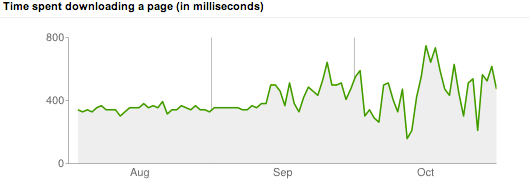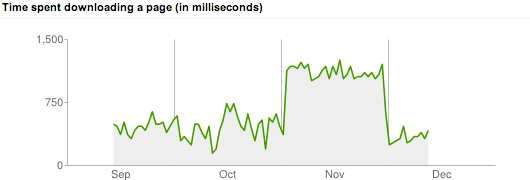CloudFlare experiment
For about a month I have served this website using the CloudFlare free plan. This article describes what I observed.
Why
Let me first explain why I started using CloudFlare. Earlier this year I migrated this blog from Django to a static site. At the same time I also switched from hosting at Zest Software back to my old hosting provider, bHosted. Still, I expected to see a drop in the time required to download a page and thus in the related graph in the Google Webmaster Tools. This is what I saw:

As of October 1st—when I made the switch—the time needed to download a page didn’t necessarily drop; instead it became more erratic and often higher than it was before.
I guessed that the expected speed improvement of having a static site was negated by hosting the site on another server. At Zest my site was dynamic but ran on a server that had a very light load and was only hosting a couple of sites. And at bHosted the site is running on a shared server with a load of 2–4 (based on a few samples) and several hundred other sites.
I then by chance stumbled upon the content delivery network provided by CloudFlare. And they even have a free plan.
Setup and first experience
First of all, the video on the CloudFlare homepage is absolutely right about how easy it is to setup. Sure, I know a bit about DNS but basically they do not require you to do very hard stuff. In fact, the most complicated I had to do was to change the name servers so they pointed to CloudFlare. (Actually: I found out that I could not change them myself so I had to ask my domain registrar to do this for me.)
Unfortunately I lost the screenshots I made of my CloudFlare statistics. But according to those statistics, CloudFlare handled about half of the requests and traffic. And, on the side, also blocked quite a few, supposedly, malicious requests.
I made the switch around the 1st of November. I expected that the time to download a page would be more stable but also that is would be lower. (That’s one of the benefits of a content distribution network, right?) Well, I was partially right…

As you can see, the time to download a page indeed did not fluctuate as much anymore. But the download time increased dramatically! And that is the reason why I switched back to serve the content directly from the bHosted server at the end of November, as you can see in the graph.
Google also assigned “special crawl rate settings” in the period I was using CloudFlare. I am not sure what this means and if it’s positive or not. Either way, within a week after taking CloudFlare out of the loop, it was back to normal.

Measurements
Before I decided to switch back to just bHosted, I tried to do some
experiments to see if I could reproduce the differences measured by
Google. I gathered circa 30 URLs (the home page, the ten most recent
articles, a number of popular articles and a (more or less) random
selection) and told Siege to have
a crack at it. More specifically I used the options “benchmark” (to
run the requests without a delay), “internet” (which randomly hits
the URLs I selected) and “concurrent” to experiment with different
number of concurrent users. These tests ran for 60 seconds each.
Since the bHosted servers are located in The Netherlands, I decided to make the measurements a bit more fair. So I did not run the test from my home (also in The Netherlands), but a RamNode VPS hosted in Atlanta, Georgia.
Results
The shortest transaction for both servers was stable: for bHosted it was 0.21 seconds and for CloudFlare it was 0.14 seconds. The average response time is also comparable (the right graph lines in the image below). The longest transactions however, differed a bit more.

Transaction times: bHosted vs CloudFlare (raw data, created via RAWGraphs)
The transaction rate of bHosted and CloudFlare seem to be comparable. (Except for a spike in the bHosted setup at 50 concurrent simulated users. But this could just be a happy accident…)

Transactions/sec: bHosted vs CloudFlare (raw data, created via RAWGraphs)
Summary
As you may have guessed, I am absolutely not an expert on the matter. But what I conclude from this data is that there is not that much difference between serving pages directly from a bHosted server or putting CloudFlare in between.
Sure, the longest transaction time in the CloudFlare setup is larger in some situations. But for my blog 100+ concurrent users are unlikely. (As a matter of fact in December an average of about 150 pages are requested per day. And Google only indexes an average of 80 pages per day at the moment of writing.) More importantly: the average transaction time for bHosted and CloudFlare is practically the same.
Conclusion?
I am sure you should not draw the conclusion that using CloudFlare is a bad thing. Nor do I want to complain about their service—after all I did not pay them a dime. Having said that, my personal conclusion was that since Google is using site speed in web search ranking this site is better off by not using CloudFlare. Your mileage may vary.